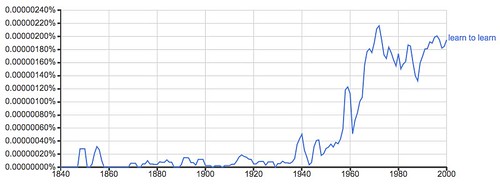I have a few remarks in response to the recent dialog with Howard Rheingold, Mia Zamora, Alec Couros, Lee Skallerup Bessette, Charlotte Pierce, and Joe Corneli on Co-learning and Authority. What interests me is the question that Mia Zamorra brought up at the end (47:43): Why co-learning now?
But I don’t want to go there directly. Let’s meander just a bit. In the following remarks I’m thinking out loud. There’s a lot of guessing and surmising. But I bring in a bit of concrete evidence at the end.
Learning and Acquisition
The question of how young kids learn came up early in the conversation. Learn what? I ask because one of the things Noam Chomsky did was change how we think about language learning. He observed that children don’t “learn” language in the ordinary sense of the term, which implies deliberate focused activity. They just “hoover” it up; that is, there is little or no deliberate learning or, for that matter, instruction. “Acquisition” has become the term of art, “first-language acquisition.”
Second language learning in adulthood, in contrast, is learning in the ordinary sense. So is learning arithmetic, or, for that matter, learning to ride a bicycle. What’s the underlying difference between “natural” acquisition and effortful learning?
I suspect there is something of a continuum between the two modes and that acquisition tapers off after adolescence, when brain maturation is almost complete (there’s incremental growth into the early twenties). Further, we don’t really engage children in sustained effortful learning until formal schooling begins at six or so. In Piagetian terms, formal learning begins with the concrete operations period of cognitive growth and acquisition ends with the commencement of formal operations.
We might put the issue in a broader perspective: Is focused effortful learning uniquely human or is it widespread among animals? I’m going to guess that, with a major qualification, it’s uniquely human. The qualification is that humans can and do train animals to do all sorts of things, and that training is effortful learning.
The Emergence of Formal Schooling
Assuming that’s more or less correct, when did deliberate effortful learning appear in human phylogeny? I’d say that the oldest evidence we’ve got is the creation of stone implements, ax heads in particular, and that goes back about two million years. That would have required deliberate learning. Just how that learning took place is, of course, a mystery. But I’d guess that it was mostly a matter of imitating skilled practitioners combined with a bit of deliberate instruction from practitioners.
And that, I believe, is how most deliberate learning takes place in preliterate societies. Children imitate adults and older children and the latter provide some deliberate help and instruction, but there are no organized courses of study. I suspect – and here I’m guessing (if anyone actually knows, please chime in) – that apprenticeship is the first kind of formal learning to develop. I’d be curious to know about interaction among apprentices under and single master: was there a form of co-learning among them?
The regime of formal schooling we’re familiar with is quite recent. I’d guess it’s basically from the 19th century, with earlier roots of various kinds including, of course, the university system with its roots in the medieval university. As I’ve noted in earlier posts this regime presupposes an early period of learning that comes to a more or less abrupt end when one goes to work.
Why Co-learning Now?
For various reasons this regime is no longer viable. We’ve entered a world where lifelong learning has become necessary. In this context, co-learning is not only a vehicle for life-long learning but may be the best and most-effective means we have for routinizing learning to learn. It is one thing to learn under the tutelage of an instructor, it is another thing to be able to learn under one’s own initiative and guidance.
Moreover it's one thing for a highly skilled individual to do something at the top of his or her game – e.g. Newton inventing the calculus and synthesizing classical mechanisms. It's quite something else for people of ordinary ability in ordinary circumstances to do the same thing – college sophomores doing physical problems. The latter is routinizing. That's what makes a skill widely available in a population.
The phrase “learn to learn” seems to be relatively recent. Here’s an Ngram graph:
While the phrase, and presumably the concept, seems to have 19th century roots, it didn’t really take off until the 1960s. Just why it took off then, I don’t know. But I note that at that time American education had become a specific concern in wake of Russia’s Sputnik launch and higher education was undergoing a rapid expansion though an influx of federal money. That’s also when the ideas of Jean Piaget began to gain traction in educational and psychology circles.
“Lifelong learning” is more recent:
It’s got mid-century roots, but didn’t really take off until the 1990s. That is, its roots are in the period when “learn to learn” entered the upward sweep of its “hocky stick” developmental curve but it didn’t take off until “learning to learn” had plateaued after 1970 or so. I’d guess that the prevalence of lifelong learning is a response to rapid technological change and the retirement of the large baby boomer generation.
As for co-learning, when I made the query I got this message: “No valid ngrams to plot!” I’m not surprised. But surely co-learning is on the rise, for it’s the means to making learning to learn a routine accomplishment of lifelong learning.


No comments:
Post a Comment